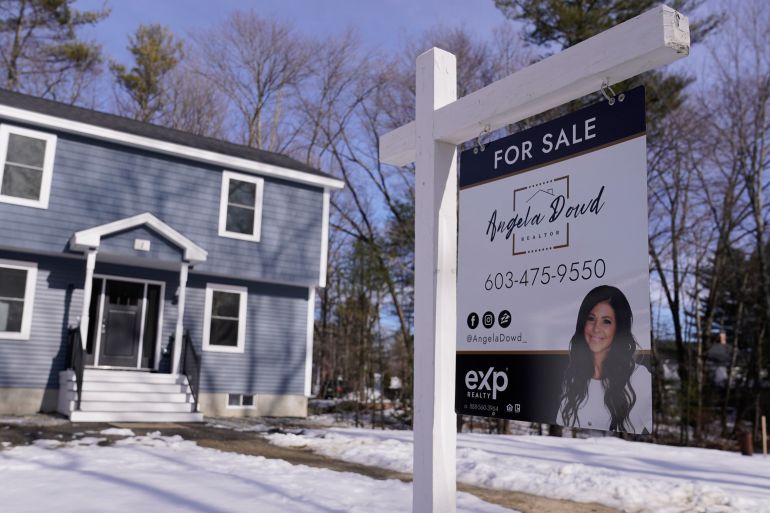In the US, higher interest rates are forcing people to cut back
Americans are feeling pinch of high interest rates, forcing them to hold off purchases of homes, cars, even groceries.

Between high interest rates and a soaring inflation, Amearah Elsamadicy, a law student and mother of two who lives in St Louis, Missouri, has been feeling the “strain”, she said. “It’s definitely led to disagreements at home.”
“Over the summer, my husband and I wanted to go to a wedding to introduce our new baby to relatives,” she said. “In the end, he travelled alone. We’re trying not to have debt hanging over us, so we’ve cut back on doing things together as a family.”
Keep reading
list of 4 itemsAs US inflation ticks back up, it could impact the presidential election
Will the US unemployment rate continue at historic lows?
The UK’s new minimum wage ‘badly needed’ but many calling for more
Elsamadicy is one of the hundreds of thousands of Americans feeling the pinch of the United States Federal Reserve’s aggressive push to bring down soaring inflation from a peak of more than 9 percent last year in June closer to its target of 2 percent.
In the process, it has raised its benchmark interest rate from near zero in March 2022 to 5.25-5.55 percent now. Even though it didn’t raise rates at its previous meeting in September, it did indicate that interest rates will continue to remain “higher for longer” as it tries to vanquish inflation.
Recent external shocks – a sharp escalation of tension in the Middle East and the renewed possibility of a near-term US government shutdown – have intensified the debate about whether the Fed will raise rates yet again this week.
The Fed’s task has been further challenged by the fact that despite seismic shifts in monetary policy, unemployment, which typically rises with higher interest rates, remains at multi-decade lows, with just 3.8 percent of Americans out of a job.
And while inflation took a bite out of real wages in 2021 and 2022, workers have seen pay gains run ahead of inflation since March, buoying consumption. Retail sales in August showed a 2.5 percent increase from the same period last year.
According to Dean Baker, co-founder of the Washington, DC-based Centre for Economic and Policy Research, “the US economy represents a nuanced picture. Higher borrowing costs are starting to take a toll, but the labour market remains strong and Americans are continuing to shop.”
Meanwhile, total consumer debt hit a record high of $17.06 trillion in the second quarter of 2023, a spike of $2.9 trillion since the end of 2019. “But,” says Baker, “most borrowing in the US is tied to housing, and house prices remain high.”
Simply put, the elevated borrowing costs have led to higher liabilities.
When the Fed increases its benchmark rate, it raises the cost of credit throughout the economy. All new lending – credit card payments, auto loans, mortgages – is impacted. Pre-existing floating rate contracts also shoot up.
“To be clear, plenty of borrowers are struggling. Rising interest has made it increasingly difficult for Americans to check off major milestones like starting a business or buying a car,” said Baker.
“The picture obviously varies for people. For retirees and folks at the low end of the income spectrum, frustration has understandably shifted from inflation to high borrowing costs. The same goes for people who want to purchase a home,” he added.
These risks continue to cloud the outlook for the US economy.
“The possibility of a recession becomes more likely if rates remain high for a long period of time,” said Baker. “But it’s not in the Fed’s interest to set off a wave of bankruptcies.”
‘Maybe one day we can afford to buy a house’
The archetypical American success story has long involved home ownership. Today, the homeownership rate is 66 percent and home equity remains most Americans’ only source of material wealth.
During the pandemic, house prices received a shot in the arm as remote workers spread out to less urban areas in search of more space. Between December 2020 and December 2021, the median home value increased by $52,667 (that’s higher than the pay of a median worker who earned $50,000).
Although housing demand has started to cool, mortgage rates remain sky-high, doubling over the past 18 months to 7.79 percent on 30-year fixed rates. Approximately 95 percent of all US mortgages are fixed-rate.
According to data from real estate analytics firm Black Knight, more than 40 percent of all US mortgages originated in 2020-2021, when interest rates were near-zero. In turn, many Americans have been reluctant to list their homes, as moving would increase their mortgage costs.
There are now 40 percent fewer homes for sale compared with before the pandemic, which has raised prices. In turn, 2.4 million potential buyers have been priced out of buying a house over the past year, as reported by Harvard University.
“My wife and I had our second child this year,” says Giulio del Bufalo who works in advertising in Brooklyn, New York. “We’ve been in a rented two-bed for a while. Last year, we started looking to buy a three-bedroom. But at current rates, mortgages are double what they were when we started looking.”
Elevated mortgage costs have exacerbated wealth inequality. Homeowners’ median net worth now is 40 times greater than that of renters, much of which was accrued since 2020.
“Prices were already rising back in 2019, but the pandemic supercharged those trends,” said del Bufalo. “Maybe one day we can afford to buy a house, but not now.”
Costly cars

High interest rates are crimping other purchases as well, such as cars.
Average monthly new car payments rose to an all-time high of $730 in the second quarter of this year. In other words, the typical American now spends roughly 10 percent of what they earn each month to pay for their new vehicle.
This is on top of already high vehicle prices, driven by a rise in demand during the pandemic and a shortage in supply on the back of shuttered factories, semiconductor shortages and disrupted shipping lines.
All told, new vehicle prices rose by 30 percent from March 2020 to March 2023 according to Kelley Blue Book, a California-based vehicle valuation and research firm.
As a result, at current prices, paying off a new car for the average American household amounts to 42 weeks of income, up from 33 weeks before the pandemic.
Angelique Spencer, who’s retired and lives in Bellingham in Washington State is looking to buy a car for her mother. “Mom always used to buy used, but she’s pushing 80 [years old] now. We want to get a new car so that if there’s a problem, she can get service coverage,” she told Al Jazeera.
“I’ve done the math, and for a $40,000 car, she’d need to pay about $600 a month. She couldn’t afford that by herself, so I’d have to help out. But if auto rates rise again, or if the car company tries to second-fiddle her credit score, I’m not sure what our options would be.”
In the first two quarters of 2023, auto loan delinquencies rose across all age groups. The increase was largest among those under the age of 30. The squeeze faced by young borrowers will soon notch higher, as payment holidays for student loans expired last month.
Spencer added, “She needs a car. Mom lives in Texas where public transport is limited. But helping her out will have financial implications for me. I may have to cut back on food and medication. Still, we’re hoping to be able to stay one step ahead of the loan.”
Credit card struggles
Americans are also trying to stay a step ahead of credit card loans – the most common form of debt in the United States with 84 percent of adults possessing at least one.
For the past five consecutive quarters, credit card balances – the total amount owed – have risen due to rising interest rates credit and were 16 percent higher in the second quarter this year compared to a year earlier as cards now carry an average interest rate of 20.72 percent.
New credit card delinquencies – accounts which are 30 days past due – hit 7.2 percent during the April-June quarter, higher than pre-pandemic levels of 6.86 percent, in the second quarter of 2019.
Card balances actually fell during 2020. COVID-19 stimulus checks, repayment holidays and foregone consumption boosted savings accounts. But that snapped back after 2021 owing to a pick-up in ‘normal’ spending, followed by high inflation.
As savings shrank, consumers became dependent on debt again to maintain their standard of living. As of February, 37 percent of adults said they used credit cards to cover their basic living expenses.
In its latest household debt report, the New York Fed calculated that card balances rose by $45bn, or 4.6 percent, on a quarterly basis, surpassing $1 trillion for the first time.
“In the past year, I’ve had to do a delicate dance each time I go to the grocery store,” said Elsamadicy, the law student living in St Louis. “I’ve had to weigh up the quality of my food against what I can afford to buy on credit.”
“I feel like credit card rates have increased by 200 percent over the past year. It hits me hardest when I’ve paid down a big chunk of debt, and then two months later it shoots back up again … like I’m back to square one,” said Elsamadicy. “We’re having to cut back on restaurants and vacations just to stay on top of credit card bills.”